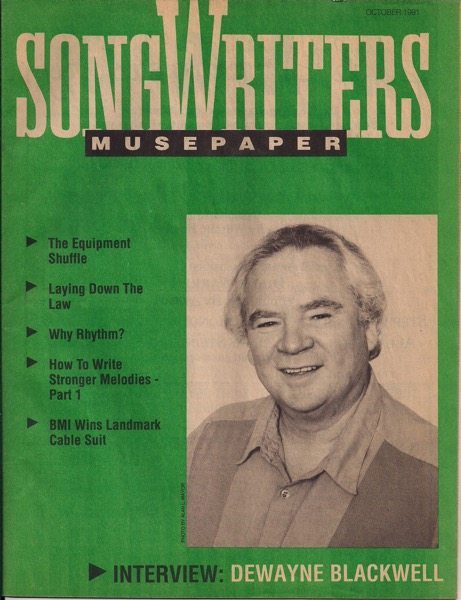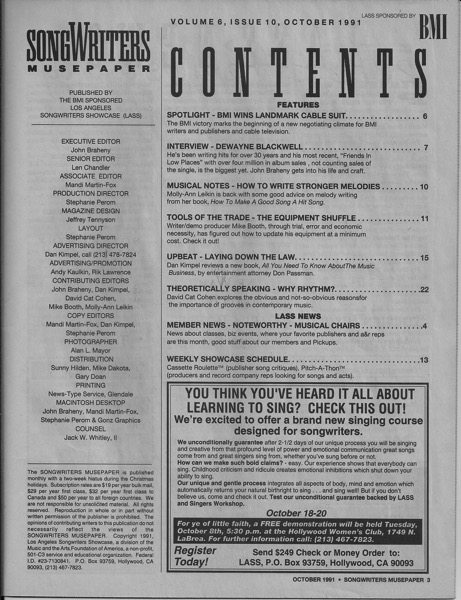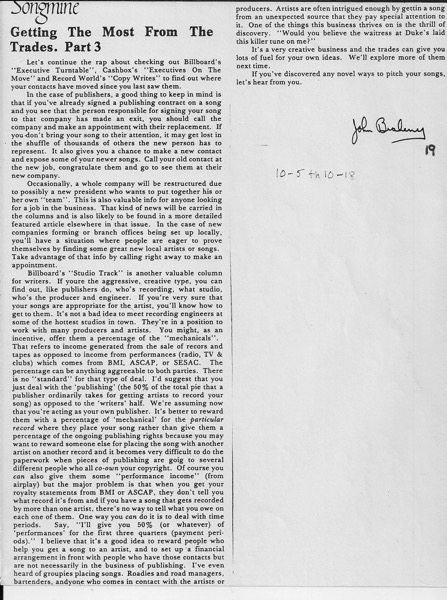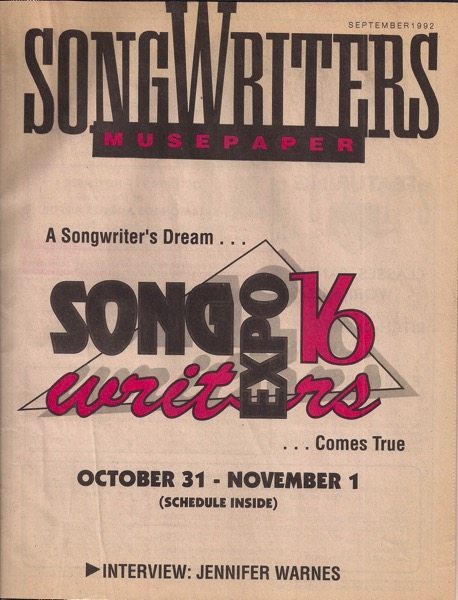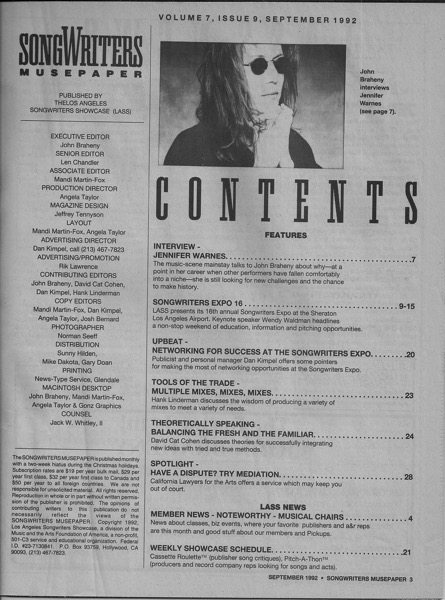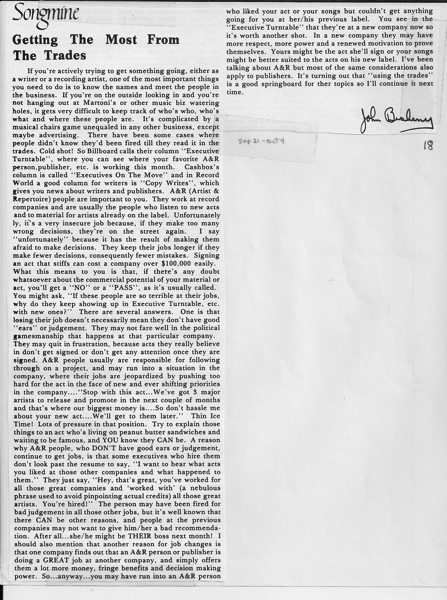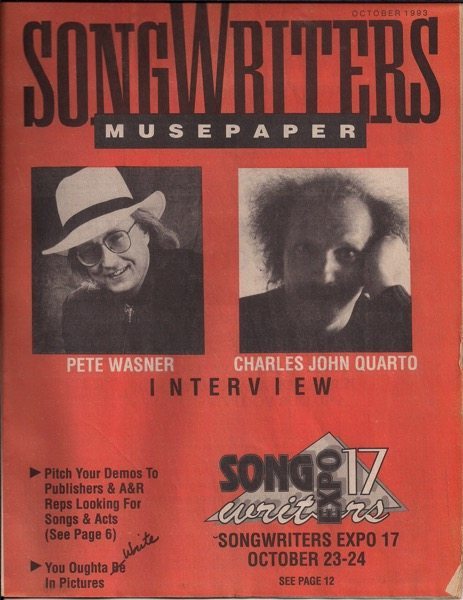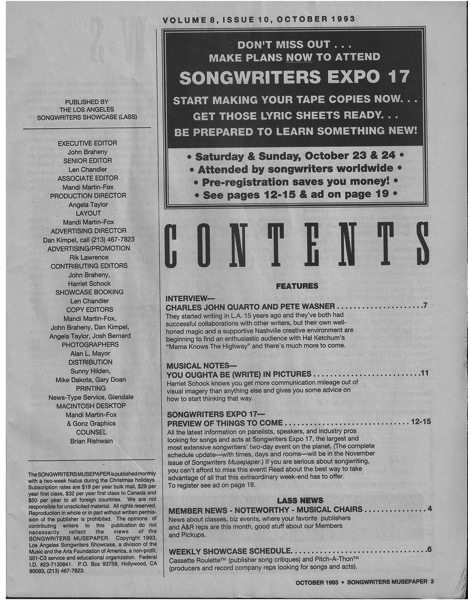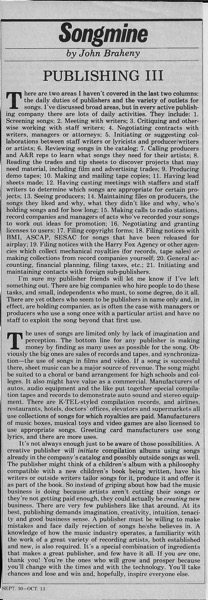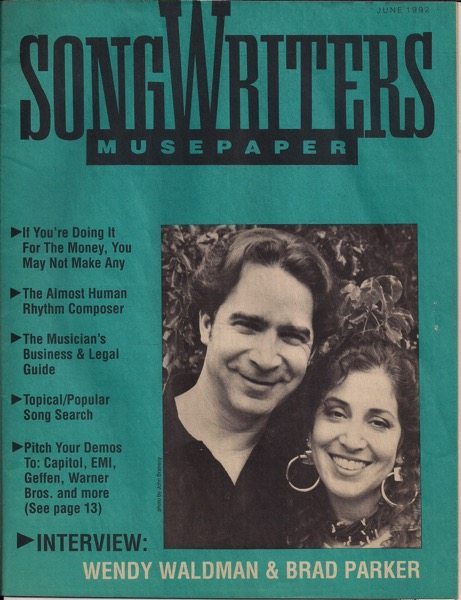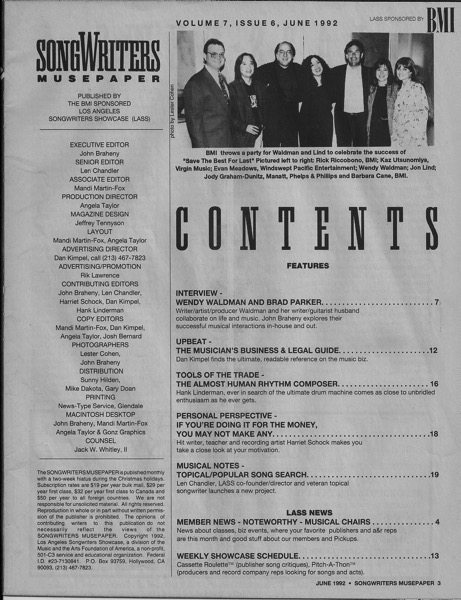A John Braheny Songmine column from the archives…
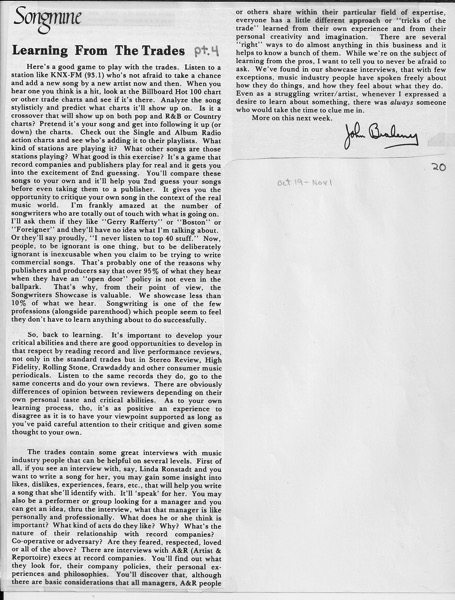
Accession Number: C000000137-008 Document/Digital File, “Songmine: Getting the Most from the Trades Part 4 by John Braheny, OCR converted text under same Accession Number
(Digitally converted text. Some errors may occur)
Songmine: Learning From The Trades Part 4 by John Braheny
Songmine: Learning From The Trades Part 4
Here’s a good game to play with the trades. Listen to a station like KNX-FM (93.1) who’s not afraid to take a chance and add a new song by a new artist now and then. When you hear one you think is a hit, look at the Billboard Hot 100 chart or other trade charts and see if it’s there. Analyze the song stylisticly and predict what charts it’ll show up on. Is it a crossover that will show up on both pop and R&B or Country charts? Pretend it’s your song and get into following it up (or down) the charts. Check out the Single and Album Radio action charts and see who’s adding it to their playlists. What kind of stations are playing it? What other songs are those stations playing? What good is this exercise? It’s a game that record companies and publishers play for real and it gets you into the excitement of 2nd guessing. You’ll compare these songs to your own and it’ll help you 2nd guess your songs before even taking them to a publisher. It gives you the opportunity to critique your own song in the context of the real music world. I’m frankly amazed at the number of songwriters who are totally out of touch with what is going on. I’ll ask them if they like “Gerry Rafferty” or “Boston” or “Foreigner” and they’ll have no idea what I’m talking about. Or they’ll say proudly, “I never listen to top 40 stuff.” Now, people, to be ignorant is one thing, but to be deliberately ignorant is inexcusable when you claim to be trying to write commercial songs. That’s probably one of the reasons why publishers and producers say that over 95 % of what they hear when they have an “open door” policy is not even in the ballpark. That’s why, from their point of view, the Songwriters Showcase is valuable. We showcase less than 10% of what we hear. Songwriting is one of the few professions (alongside parenthood) which people seem to feel they don’t have to learn anything about to do successfully.
So, back to learning. It’s important to develop your critical abilities and there are good opportunities to develop in that respect by reading record and live performance reviews, not only in the standard trades but in Stereo Review, High Fidelity, Rolling Stone, Crawdaddy and other consumer music periodicals. Listen to the same records they do, go to the same concerts and do your own reviews. There are obviously differences of opinion between reviewers depending on their own personal taste and critical abilities. As to your own learning process, tho, it’s as positive an experience to disagree as it is to have your viewpoint supported as long as you’ve paid careful attention to their critique and given some thought to your own.
The trades contain some great interviews with music industry people that can be helpful on several levels. First of all, if you see an interview with, say, Linda Ronstadt and you want to write a song for her, you may gain some insight into likes, dislikes, experiences, fears, etc., that will help you write a song that she’ll identify with. It’ll ‘speak’ for her. You may also be a performer or group looking for a manager and you can get an idea, thru the interview, what that manager is like personally and professionally. What does he or she think is important? What kind of acts do they like? Why? What’s the nature of their relationship with record companies? Co-operative or adversary? Are they feared, respected, loved or all of the above? There are interviews with A&R (Artist & Reportoire) execs at record companies. You’ll find out what they look for, their company policies, their personal ex-periences and philosophies. You’ll discover that, although there are basic considerations that all managers, A&R people or others share within their particular field of expertise, everyone has a little different approach or “tricks of the trade” learned from their own experience and from their personal creativity and imagination. There are several “right” ways to do almost anything in this business and it helps to know a bunch of them. While we’re on the subject of learning from the pros, I want to tell you to never be afraid to ask. We’ve found in our showcase interviews, that with few exceptions, music industry people have spoken freely about how they do things, and how they feel about what they do. Even as a struggling writer/artist, whenever I expressed a desire to learn about something, there was always someone who would take the time to clue me in. More on this next week.
OCT 19 – NOV 1
Previously in the Songmine Collection:
- Songmine: Getting the Most from the Trades Part 3 by John Braheny
- Getting the Most from the Trades
- Songmine: Publishing III
- Songmine: Leave Your Ego at the Door
- Songmine: “Feedback: Why some publishers won’t give it”
- Songmine: Dealing with Rejection by John Braheny
- “Music in Print” – A Songmine Column from Music Connection Magazine March 19-April 1, 1981
About Songmine and Music Connection Magazine:
John Braheny met Eric Bettelli and Michael Dolan right before they were going to publish Music Connection magazine. Eric and Michael wanted to get their publication out to as many songwriters as they could. They had already heard of the LA Songwriters Showcase, and of John and his partner, Len Chandler. John’s goal was to advertise the schedule of guest speakers and performers at the weekly Showcase… so they made a deal.
They published John’s Songmine column (he had never before written a magazine article!) in their very first edition, in November 1977. Trading out the column for advertising, this arrangement continued for many years. Plus, Eric and Michael came to the Showcase each week and distributed free copies to the songwriters!
Those articles became so popular that (book agent and editor) Ronny Schiff offered John’s articles to F&W Media, where they became the backbone of John’s textbook, The Craft and Business of Songwriting. As a follow-up, Dan Kimpel (author, songwriter, teacher), who had also worked at LASS, took on the Songwriting column at Music Connection magazine which continues to this day! You can subscribe to get either hard copies or online.
Songmine: Learning From The Trades Part 4
Here’s a good game to play with the trades. Listen to a station like KNX-FM (93.1) who’s not afraid to take a chance and add a new song by a new artist now and then. When you hear one you think is a hit, look at the Billboard Hot 100 chart or other trade charts and see if it’s there. Analyze the song stylisticly and predict what charts it’ll show up on. Is it a crossover that will show up on both pop and R&B or Country charts? Pretend it’s your song and get into following it up (or down) the charts. Check out the Single and Album Radio action charts and see who’s adding it to their playlists. What kind of stations are playing it? What other songs are those stations playing? What good is this exercise? It’s a game that record companies and publishers play for real and it gets you into the excitement of 2nd guessing. You’ll compare these songs to your own and it’ll help you 2nd guess your songs before even taking them to a publisher. It gives you the opportunity to critique your own song in the context of the real music world. I’m frankly amazed at the number of songwriters who are totally out of touch with what is going on. I’ll ask them if they like “Gerry Rafferty” or “Boston” or “Foreigner” and they’ll have no idea what I’m talking about. Or they’ll say proudly, “I never listen to top 40 stuff.” Now, people, to be ignorant is one thing, but to be deliberately ignorant is inexcusable when you claim to be trying to write commercial songs. That’s probably one of the reasons why publishers and producers say that over 95 % of what they hear when they have an “open door” policy is not even in the ballpark. That’s why, from their point of view, the Songwriters Showcase is valuable. We showcase less than 10% of what we hear. Songwriting is one of the few professions (alongside parenthood) which people seem to feel they don’t have to learn anything about to do successfully.
So, back to learning. It’s important to develop your critical abilities and there are good opportunities to develop in that respect by reading record and live performance reviews, not only in the standard trades but in Stereo Review, High Fidelity, Rolling Stone, Crawdaddy and other consumer music periodicals. Listen to the same records they do, go to the same concerts and do your own reviews. There are obviously differences of opinion between reviewers depending on their own personal taste and critical abilities. As to your own learning process, tho, it’s as positive an experience to disagree as it is to have your viewpoint supported as long as you’ve paid careful attention to their critique and given some thought to your own.
The trades contain some great interviews with music industry people that can be helpful on several levels. First of all, if you see an interview with, say, Linda Ronstadt and you want to write a song for her, you may gain some insight into likes, dislikes, experiences, fears, etc., that will help you write a song that she’ll identify with. It’ll ‘speak’ for her. You may also be a performer or group looking for a manager and you can get an idea, thru the interview, what that manager is like personally and professionally. What does he or she think is important? What kind of acts do they like? Why? What’s the nature of their relationship with record companies? Co-operative or adversary? Are they feared, respected, loved or all of the above? There are interviews with A&R (Artist & Reportoire) execs at record companies. You’ll find out what they look for, their company policies, their personal ex-periences and philosophies. You’ll discover that, although there are basic considerations that all managers, A&R people or others share within their particular field of expertise, everyone has a little different approach or “tricks of the trade” learned from their own experience and from their personal creativity and imagination. There are several “right” ways to do almost anything in this business and it helps to know a bunch of them. While we’re on the subject of learning from the pros, I want to tell you to never be afraid to ask. We’ve found in our showcase interviews, that with few exceptions, music industry people have spoken freely about how they do things, and how they feel about what they do. Even as a struggling writer/artist, whenever I expressed a desire to learn about something, there was always someone who would take the time to clue me in. More on this next week.
OCT 19 – NOV 1
